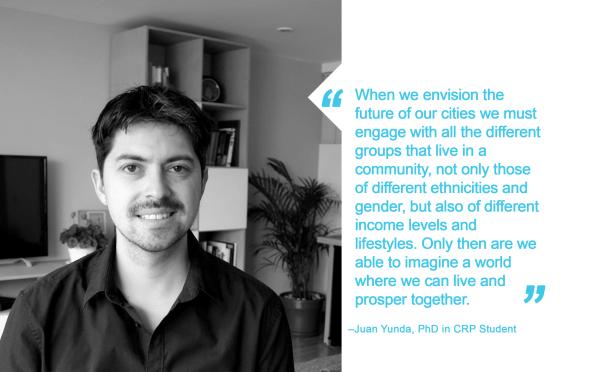Juan Yunda, Student

In this post, we speak with Juan Yunda. He has an undergraduate degree in architecture and a joint master's degree in urban studies from Bauhaus-Weimar University and Tongji University in Shanghai. While at UT, Juan has developed his research interests in social-spatial segregation and its implications for urban form, and the future of informal settlements in Latin American cities and regions.
In the School, what degree are you seeking? What year are you in?
My name is Juan Yunda, I am a third-year Ph.D. student in the program Community and Regional Planning
In what ways have you incorporated diversity and equity issues as part of your educational experience?
In urban planning, diversity is a key concept. When we envision the future of our cities we must engage with all the different groups that live in a community, not only those of different ethnicities and genders but also of different income levels and lifestyles. Only when we are able to understand the different group’s positions, interests and values we are able to imagine a world where we can live and prosper together. As result, most of our planning classes at the school of architecture engage with diversity concerns. I am proud to have experienced how students and faculty at UT in almost every class are aware of the challenges that come from multicultural societies. We are lucky as a public and internationally well-known institution to attract a student body with very different backgrounds and this encourages the dialogue needed to cope with such challenges.
What does diversity mean to you?
Diversity in my view is the recognition of the other. It is a word that makes us realize that we are all different and that, as result, we should try not to just engage with those similar to us. Every time we hear the word diversity we must think about the different people in our classes, neighborhoods, and cities, and ask ourselves if our societies are fair with all each of us. Diversity is the opposite of oppression and reminds us of the different points of view that exist and the value of solutions that come from conversation, negotiation, and empathy.
Can you describe the sense of community at the School?
The sense of community in our school exists at different scales. Students group each other according to their fields of study, whether they are graduates or undergraduates, according to their interests, there are groups of minorities and gendered communities. There are several different groups, and this is natural. What is important is that there are many platforms in the school of architecture for both community building and interaction among different communities. Examples of these are events such as talks and happy hours. They are ways to enhance the interaction among students of different backgrounds. On the larger scale, the strong identity around the school, which includes the different sports, cultural events, and even the Texan traditions, builds in us a sense of community also at the university level.
What are your aspirations –big or small– for the future?
I used to have large aspirations for my future, but as I enhance my learning, both within my field, and in my general understanding of society I tend now to be more focused. In order to make a difference in our complex contemporary world, I think one should find a very specific goal. In my case, as an international student, I feel my duty is to return to my home country and teach. I find that sharing my life experiences with others is not secondary to professional practice, on the contrary, it is standing in the front line in our battle to make each day better citizens for a better future.

